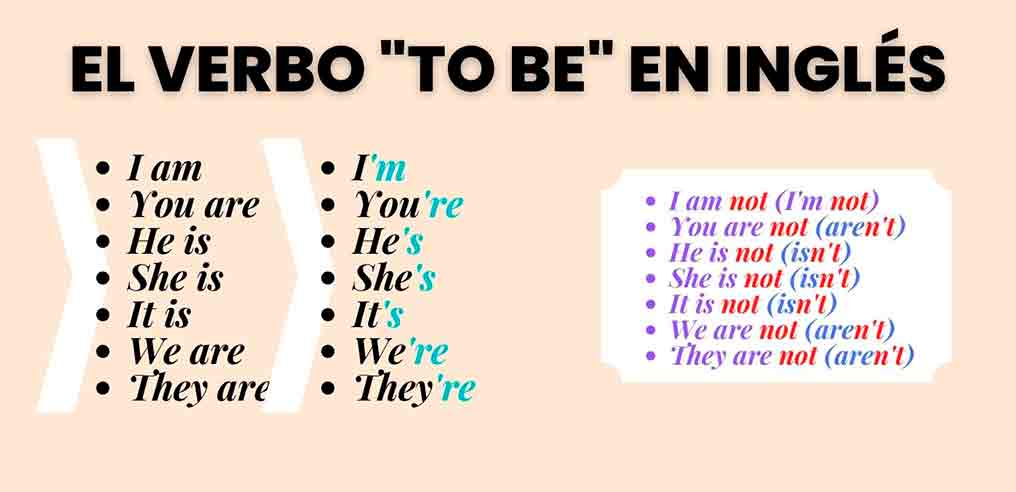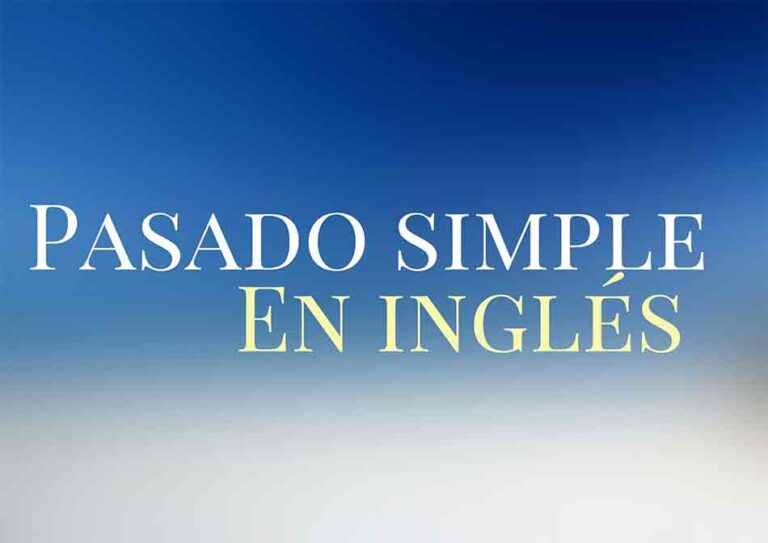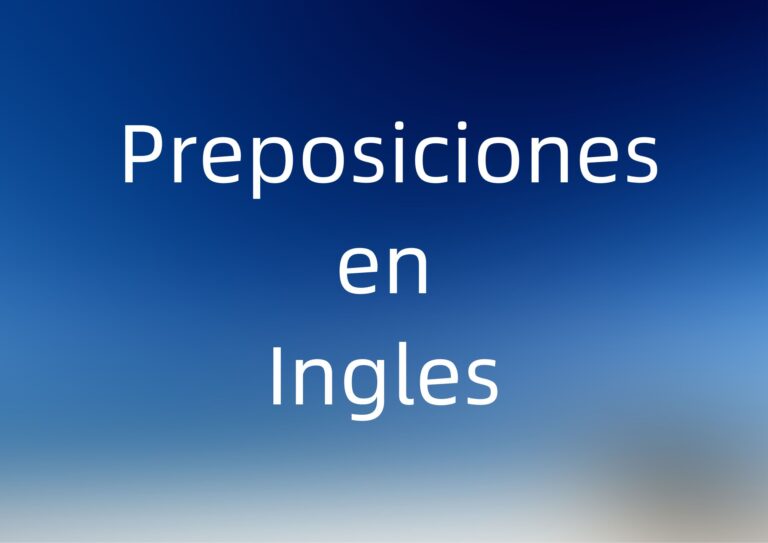El Verbo To Be En Inglés
El Verbo To Be En Inglés
El “Verbo TO BE en Ingles” es uno de los verbos más importantes y fundamentales en la lengua inglesa. Su traducción al español es “ser o estar”. Es un verbo de conexión, es decir, se utiliza para unir el sujeto y el complemento en una oración. Por ejemplo, en la oración “I am a student” (Soy un estudiante), el verbo “to be” conecta el sujeto “I” (yo) con el complemento “a student” (un estudiante).
Table of Contents
ToggleEs importante tener en cuenta que el verbo “to be” tiene diferentes formas, dependiendo del tiempo verbal en el que se utilice y del sujeto con el que se conjuga.
El verbo “to be” es uno de los verbos más importantes y fundamentales en la lengua inglesa. Su traducción al español es “ser o estar”. Es un verbo de conexión, es decir, se utiliza para unir el sujeto y el complemento en una oración. Por ejemplo, en la oración “I am a student” (Soy un estudiante), el verbo “to be” conecta el sujeto “I” (yo) con el complemento “a student” (un estudiante).
Es importante tener en cuenta que el verbo “to be” tiene diferentes formas, dependiendo del tiempo verbal en el que se utilice y del sujeto con el que se conjuga.

Forma Afirmativa del verbo TO BE en Inglés
La forma afirmativa del verbo “TO BE” se utiliza para expresar afirmaciones o verdades.
“I am” (Yo soy)
“You are” (Tú eres)
“He/She/It is” (Él/Ella/Eso es/está)
“We are” (Nosotros somos / estamos)
“You are” (Vosotros sois / ustedes son / ustedes están)
“They are” (Ellos/Ellas son/están)
Ejemplos
- “I am a student” (Soy un estudiante o Yo soy estudiante)
- “You are my friend” (Tú eres mi amigo)
- “He is tall” (Él es alto)
“She is in the park” (Ella está en el parque) - “It is a cat” (Este es un gato)
- “We are happy” (Nosotros somos / estamos felices)
- “You are welcome” (De nada) (o está bien venido)
- “They are teachers” (Ellos son maestros)
* “It“ se usa para los animales y los objetos.
Forma negativa del verbo TO BE
La forma negativa del verbo “to be” se utiliza para expresar negaciones y se agrega “Not” después del verbo to be.
“I am not” (Yo no soy/ Yo no estoy)
“You are not” (Tú no eres / Tu no estás)
“He/She/It is not” (Él/Ella/Eso no es)
“We are not” (Nosotros no somos / Nosotros no estamos)
“You are not…..” (Vosotros no sois/Estáis / Ustedes no son / Ustedes no están / )
“They are not…..” (Ellos / Ellas no son / no están)
Ejemplos:
- “I am not a student” (No soy un estudiante).
- “I am not hungry” (Yo no tengo hambre)
- “You are not at home” (Tú no estás en la casa)
- “He is not my brother” (Él no es mi hermano)
- “She is not in the park” (Ella no está en el parque)
- “We are not tired” (Nosotros no estamos cansados)
- “You are not happy” (Vosotros no estáis felices)
- “They are not sad” (Ellos no están tristes)
La forma interrogativa del verbo “to be” se utiliza para formular preguntas. Por ejemplo, “Are you a student?” (¿Eres un estudiante?). En este caso el verbo “To be” se coloca antes del sujeto.
Forma interrogativa del Verbo TO BE
“Am I?” (¿Soy/Estoy yo?)
“Are you?” (¿Eres/Estas tú?)
“Is he/she/it?” (¿Es/esta él/ella/eso?)
“Are we?” (¿Somos/estamos nosotros?)
“Are you?” (¿Sois/Estáis vosotros? ¿Son/Están Ustedes?)
“Are they?” (¿Son/Están ellos/ellas?)
Ejemplos:
- “Am I your cousin?” (¿Soy tu primo?)
- “Are you OK?” (¿Estais/Estás bien? /
- ¿Usted está bien?)
“Is he your father?” (¿Es él tu padre?) - “Is she your sister” (¿Es ella su hermana?”)
- “Are we friends?” (¿Somos amigos?)
- “Are you in the cinema?” (¿Están/Estáis en el cine?)
- “Are they ready?” (¿Están ellos listos?)
Contracciones:
Las contracciones son formas abreviadas que algunos auxiliares o verbos adoptan en contextos escritos informales. Las contracciones de “to be” son versiones más cortas de “is”, “are”, y “am” al quitar la primera letra y reemplazarlas con un apóstrofe, combinándolos con pronombres personales. Resultando: “I’m”, “he/she/it’s”, “we/you/they’re”.
Contracciones en forma Afirmativa
I am → I’m
He is → He’s
She is → She’s
It is → It’s
We are → We’re
You are→ you’re
They are → they’re
Ejemplos:
Contracción del verbo “am”
“I’m at school”. (Estoy en la escuela).
Contracción del verbo “is”
“He’s my brother”. (El es mi hermano).
Contracción del verbo “are”
“We’re from England”. (Somos de Inglaterra).
Contracciones en forma negativa
I am not → I’m not
He is not → He’s not / he isn’t
She is not → She’s not / She isn’t
It is not → It’s not / it isn’t
We are not → We’re not / We aren’t
You are not → You’re not / You aren’t
They are not → They’re not / They aren’t
Ejemplos:
Contracción del verbo “am” con “not”
“I’m not at school”. (No estoy en la escuela).
Contracción del verbo “is” con “not”
“He’s not my brother. / He isn’t my brother”. (Él no es mi hermano).
Contracción del verbo “are” con “not”
“We’re not from England. / We aren’t from England.” (Nosotros no somos de Inglaterra).
Conclusión
Es importante mencionar que el verbo “to be” también se utiliza para indicar la existencia o presencia de algo o alguien. Por ejemplo, “There is a book on the table” (Hay un libro en la mesa) o “There are three apples in the basket” (Hay tres manzanas en la cesta).
También se utiliza para describir el estado o condición de algo o alguien, por ejemplo, “I am tired” (Estoy cansado), “The weather is nice” (El clima es agradable).
En resumen, el verbo “to be” en inglés es un verbo muy importante en la lengua inglesa ya que se utiliza para conectar sujeto y complemento en una oración. Es importante tener en cuenta las diferentes formas en las que se puede utilizar, ya sea en forma afirmativa, negativa o interrogativa, para poder comunicarnos de manera clara y precisa. A través de los ejemplos proporcionados, se puede ver cómo traducir correctamente estas formas del verbo “to be” al español. Es importante practicar y utilizar estas estructuras en la comunicación diaria para mejorar la habilidad en el idioma inglés.
Ver Otros temas importantes








Do you mind if I quote a couple of your articles as long asI provide credit and sources back to your website?My blog site is in the very same niche as yours and my users would certainly benefit from some of the information you present here.Please let me know if this okay with you. Thanks!
Thank you for your interest in my articles! I appreciate you reaching out to me and asking for permission to quote my work on your blog. I am open to allowing you to use the information available on my blogs as long as proper credit and sources are provided back to my website. It is great to hear that our niches are the same and that your users could benefit from my content.
If you could please provide clear attribution and links back to the original source on my website, that would be greatly appreciated.
Thank you for your sharing. I am worried that I lack creative ideas. It is your article that makes me full of hope. Thank you. But, I have a question, can you help me?
Thank you for your kind words. I’m glad to hear that my article has given you hope and inspiration.
Of course, I’d be happy to help you with your question. What specifically are you wondering about? Feel free to ask and I’ll do my best to provide you with a helpful answer.
Your point of view caught my eye and was very interesting. Thanks. I have a question for you.
Please post your question
Thank you for your sharing. I am worried that I lack creative ideas. It is your article that makes me full of hope. Thank you. But, I have a question, can you help me?
Thank you for taking the time to read my article and for your kind words. I’m glad to hear that it has helped to inspire you and given you hope. I would be happy to help you with any questions or concerns you may have. Please feel free to ask your question, and I’ll do my best to provide you with the guidance and support you need to generate more creative ideas.
Your article helped me a lot, is there any more related content? Thanks!
“I’m glad to hear that my article was helpful to you! Please visit the index page where you’ll find a list of all the articles. Furthermore, I’ll be publishing more articles that you can find in the “Recent Posts” section on the homepage.”
Can you be more specific about the content of your article? After reading it, I still have some doubts. Hope you can help me.
Thank you for taking the time to read my article. I’m sorry to hear that you still have some doubts. I would be happy to provide you with more specific information to address your concerns. Please let me know what areas you would like me to clarify, and I’ll do my best to provide you with the information you need.
Your article helped me a lot, is there any more related content? Thanks!
I’m glad to hear that my article was helpful to you! Please visit the index (indice) page where you’ll find a list of all the articles. Furthermore, I’ll be publishing more articles that you can find in the “Recent Posts” section on the homepage.